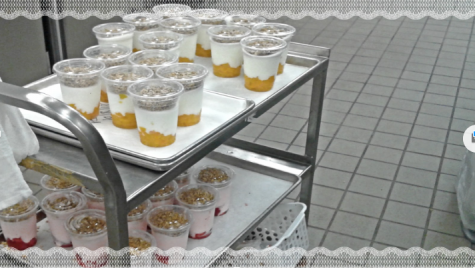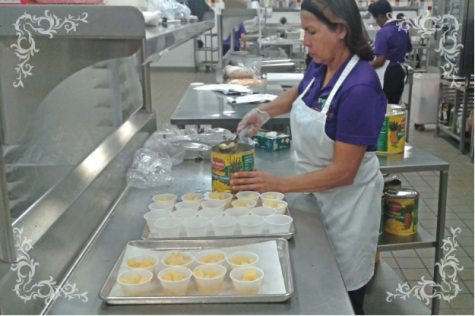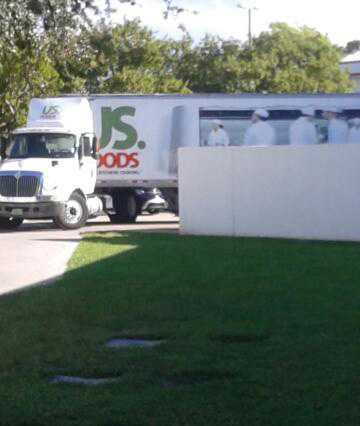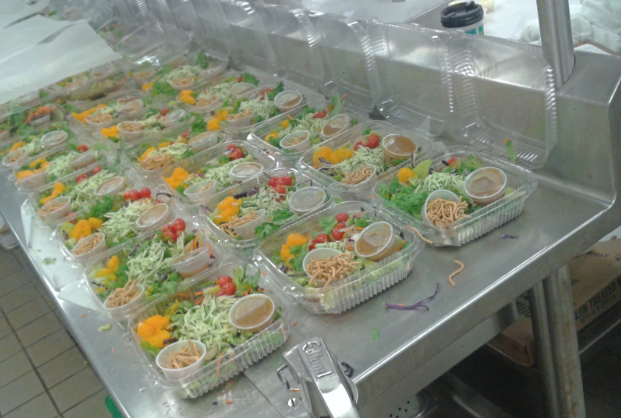Behind the Lunch
In this picture we have about 45 plus salads going down in a row. These salads are prepared from complete scratch, the sauce is also a delicious secret sauce, they also add meat into most of these salads and the veggies are distributed on a glass holder for the students to come and grab if they want.
October 27, 2018

30 Parfait ready to be set up.

Elizabeth Cano ( the assistant of the head chief Sandra Scott) is working on scooping up the fresh canned fruits and placing them into little plastic cups for the children to enjoy.

We all know the basics of public school lunch. You walk into the cafeteria, get in a line, get your lunch, sit down and eat, then you leave. But have you ever stopped to wonder where your lunch comes from, who makes it or why you have the options you do? Well, others had those questions too. Most students don’t, but if you ever venture behind the scenes here’s what you’ll see.
Upon arriving at the kitchen, you’re immediately brought to a small office in the back. The one who’s there to greet you is the school’s lunch supervising manager, Sandra Scott. She very kindly responded to all the questions that were left unanswered. Of course, the very first question was why we had these certain foods as choices. The answer given was “because it’s regulated by the USDA” which is, for those of us who don’t know, a cabinet-level agency that oversees the American farming industry.
The next question asked was who was in charge of making sure the food gets delivered on time and that there is enough for the student population.
“That would be me,” Scott replied.
“How does everything get set up beforehand?” Our interviewer asked.
“Everything gets prepped and everything gets made,” She began. “And then we put it in warmers or we put them in refrigerators like the salads.”
The next question was less concerned with food and more about time and punctuality. What is the exact time the food has to start being prepared and put on the line? “The exact time that it needs to be put on the line and ready is at 10:35.”
And last, but certainly not the least: what safety regulations do they follow?
“HACCP.” Was Scott’s short response.
“Could you explain that?”
“Hazard Analysis and Critical Control Points. That’s what we follow.” HACCP is a systematic preventive approach to food safety from biological, chemical and physical hazards in production processes that can cause the finished product to be unsafe and designs measures to reduce these risks to a safe level.
They make 1300 lunches, 500 breakfast meals and in total, they feed around 2100 kids daily. The biggest sellers they have are the beefaroni, chicken wings, pizza, and chicken tenders. But when asked what sells the least the surprising answer was that there isn’t anything that sells the least they all sell around the same amount.
Another interview took place because more questions arose from the depths of curiosity. So, going in, talking to Sandra Scott, the questions asked received their answers.
“How long have you been working in the cafeteria?”
“I’ve been working 25 years as a food nutritionist.’’
“When did you start working in this field?”
“I started in 1993.”
“What foods are made from scratch?”
“A good ¾ of the menu is made from scratch.”
Now is when the interview takes an emotional turn. No tears were shed during this interview, but the look in Scott’s eyes and the feeling you hear in the words she speaks makes you feel sympathy for these ladies.
“What do you think you guys as the Food Nutrition Services employees deserve?”
“Well, I believe we deserve a bigger paycheck, more respect from these kids, and a little thank you every now and then so that we feel appreciated.’’
“What is the hardest part of this job?”
“The hardest part is dealing with the children that have bad attitude problems and do a lot of name calling, because believe it or not those things get to us I mean it hurts our feelings and we can’t really say anything back to them or we are in the complete wrong.”
That concluded the interview with the brains behind the operation and now it was time to look at the response to the product.
Brelee Bennet is a student here at South Broward High School so the decision was made to ask her a few questions concerning the school lunch. According to Bennet, she applied for free lunch but was rejected because her father makes too much money. But then she was asked how she felt about it and her response was just the most heartwarming thing.
“I wouldn’t even get it for free since other kids are out there and can’t pay for it, so I would rather just bring my lunch,” claimed Bennet.
Since one student is never enough for a proper investigation, another student, Katelyn Matias, was brought in for questioning. This particular student doesn’t eat lunch at all.
“I don’t like going in the cafeteria because I have high anxiety problems, so I don’t want to be surrounded by too many kids at once. I don’t even feel hungry like most of these kids,” responded Matias.
“Alright thank you for your participation.”
As you can see, not many kids like the lunch served here at the school, “Why is that?” well who knows maybe they have different taste buds from others. Their way to solve not enjoying the lunch is by either bringing their own lunch or not eating it at all.



